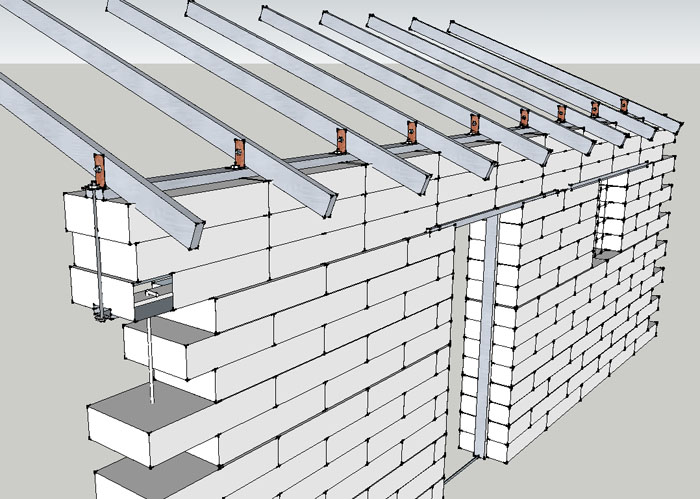How do you keep a high vertical earthbag wall that is straight from toppling over? This is always a concern when designing and building standard rectilinear buildings with earthbags. The conventional solution generally relies on periodic buttresses and/or heavy-duty reinforced concrete bond beams at the top of the wall.
I have come up with a simpler solution that is much easier to install, requires no concrete or buttresses, and also provides hurricane and earthquake protection for the walls and the roof framing. At the same time this method will automatically provide strong lintels over doors and windows.
The idea is that during construction, once you have arrived at the height where you are at the level of the top of any door or window (presuming that these are the same height), you lay down a piece of hollow, rectangular-section steel tubing right on top of that last row of earthbags. It is also possible to do this pieces of wood by using somewhat larger dimensions, but I prefer metal because it is stronger and more reliable in its characteristics. It should be as long as the wall is, going from the center of one corner to the center of the other corner. In most localities you can purchase such tubing up to 6 meters (20 feet) long, and two pieces can be strapped together if necessary, using connection plates that are either welded or bolted in place. This tubing can be various sizes, depending on how long the wall is, but I recommend about 1 1/2″ X 4″ in general.
For a complete description of this concept and step-by-step instructions for installation see earthbagbuilding.com.


I know that you can buttress the wall from the inside however, does that have to be with earthbag? Would 2×6 internal walls count as buttressing?
Internal framed walled can be used as buttresses as long as they are well secured to the earthbag walls.
Here goes I have been reading all I can about Earth bags I purchased 7.3 acres of land in Altona Ny I will be building a Earth bag Garage first 24×24. How do I figure out how many 18×30 bags will I need?
See http://earthbagbuilding.com/faqs/howmany.htm
Any update on if anyone has tried this yet, or any variations?
I am planning to build over the next two years and hope to utilize this technique (round might be strong, but can be difficult to use pre-made resources with.).
I’m pretty sure people have experimented with these methods, but so far no one has sent us a report.
my only apprehension is the straight earthbag wall itself, as we all know curved walls self buttress, straight ways are highly susceptible to lateral forces.
My suggestion would be to install either corner posting in collaboration with a top bond beam or corner and intermittent posting joining the bond beam to the foundation, and in filling with earthbags, similar to the straw bale method.
Since this is a technique that hasn’t been tried, I would seriously make test models and see their tolerances before doing a home.
Good luck with your efforts either way!!!
Peace and Love’
David Reed
New Jura Natural Building
You are right that such bond beams do need to be used in conjunction with well-connected corners and reinforced openings (possibly with rebar pins running from top to bottom) and periodic buttressing will only make it more secure. We hope to be doing some tests on this concept soon.
David: What you say is correct. However, rounded structures are often not culturally accepted. You can find many examples of good intentions by outsiders that were ultimately rejected by locals. We’re trying hard to build things people truly want and need. And to do that, we need these specialized building techniques to reinforce straight walls.
Thanks for the time spent in preparing this and for sharing it. We’re planning on using this method as well on homes we’ll start building in Haiti in June. Gary, I thought the same thing about using wood (and maybe some butressing as well). Could you send me your email address so we can so I can check in with you before we get started to see how it worked out? Mine is chiagunner@hotmail.com
Thanks for the great article. We will be using this method for a house in Haiti starting the 17th of next month. We will try using the wood because we want a process that can be duplicated by the Haitians using local material.
Thanks for all the great information! Has this method ever been tested in practice?
To my knowledge this has not been tested yet, but we are planning to do so soon.